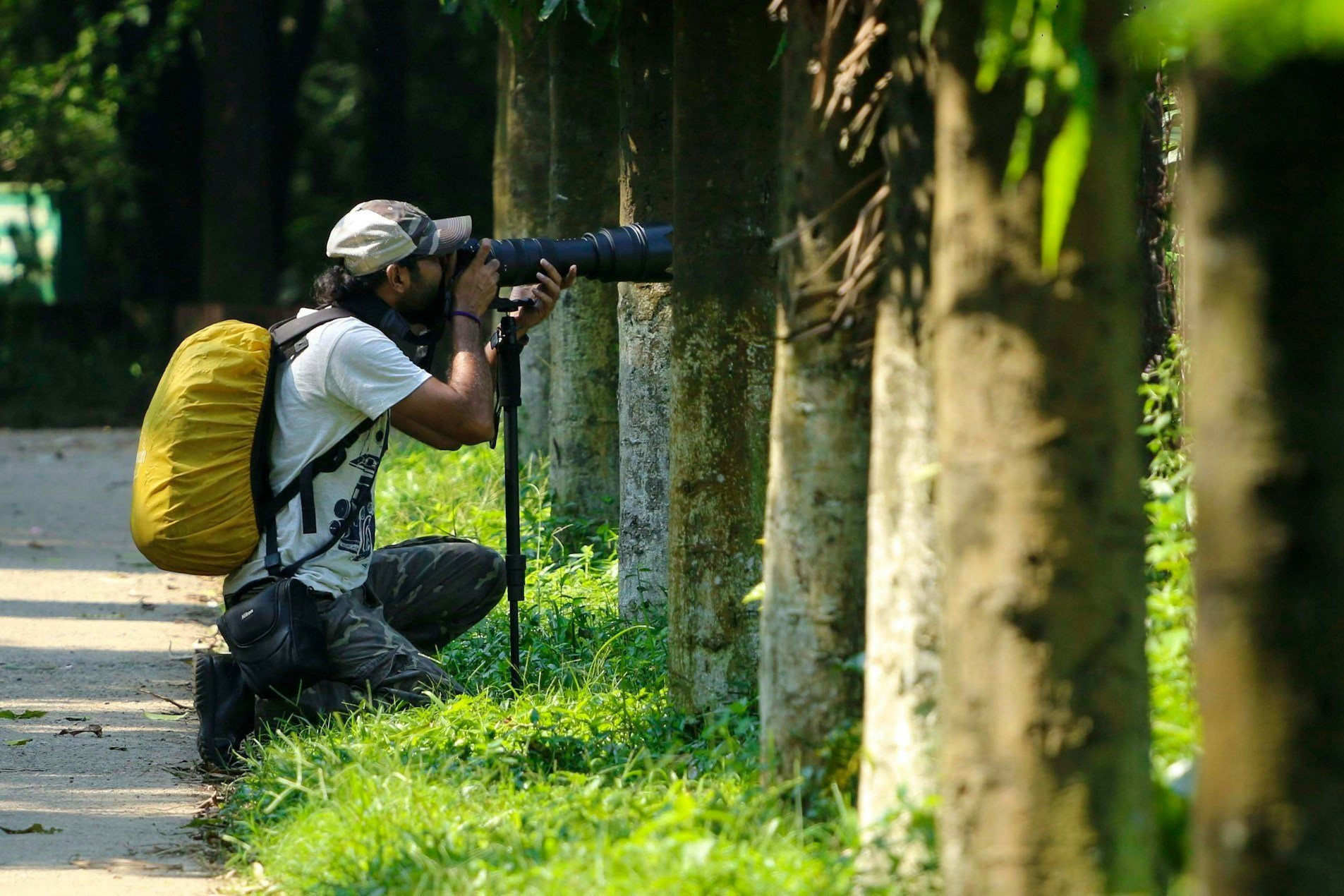Brazil vs. USA: Which Country Has the Most Incredible Wildlife?
I've always been fascinated by wildlife. As a kid, I'd spend hours flipping through National Geographic magazines, admiring creatures from around the world. But there are two countries that consistently captured my imagination: Brazil and the United States. These nations, though vastly different in many ways, are both incredible powerhouses when it comes to biodiversity.
Brazil, with its vast Amazon rainforest, sprawling Pantanal wetlands, and diverse coastal ecosystems, is often celebrated as a biodiversity hotspot. Meanwhile, the United States boasts an impressive array of landscapes—from the alligator-filled Everglades to the bear-populated forests of Yellowstone.
Amazon Rainforest, Brazil: Home to jaguars, macaws, sloths, pink river dolphins, and countless insects, the Amazon is the heartbeat of global biodiversity. (C) Vlad Hilitanu
But which country truly has the more incredible wildlife? Is it Brazil's jaguar-prowled jungles or America's bison-roamed plains? Let's dive into this fascinating comparison of biodiversity, unique species, and conservation efforts to see which country might claim the wildlife crown.
A Tale of Two Ecosystems: Understanding the Biodiversity Battleground
Before we jump into comparing specific animals, it's important to understand what makes these two countries so special in terms of wildlife.
Brazil is the fifth-largest country in the world, covering over 3.2 million square miles of South America. What makes Brazil particularly special is its range of ecosystems—from the world's largest rainforest (the Amazon) to tropical wetlands (the Pantanal), coastal Atlantic forests, and the savanna-like Cerrado region.
The United States, meanwhile, spans 3.8 million square miles across North America, encompassing everything from arctic tundra in Alaska to tropical ecosystems in Florida and Hawaii. The country features deserts, mountains, forests, prairies, wetlands, and extensive coastlines along two oceans.
Both nations host remarkable biodiversity, but in different ways. Let me break it down for you.
The Numbers Game: Which Country Has More Species?
If we're strictly counting species, Brazil takes an early lead in this competition:
Brazil's biodiversity by the numbers:
Home to an estimated 20% of the planet's biodiversity
Over 100,000 animal species
Approximately 40,000 plant species
1,800+ bird species
750+ mammal species
300+ reptile species
United States' biodiversity by the numbers:
Around 200,000 known species (plants, animals, fungi, etc.)
Approximately 20,000 plant species
Around 800 bird species
About 400 mammal species
Roughly 500 reptile and amphibian species
What's particularly impressive about Brazil is its level of endemism—species found nowhere else in the world. The Amazon alone hosts 10% of all known species on Earth, with new discoveries happening regularly. The Atlantic Forest, though severely reduced in size, has one of the highest percentages of endemic species globally.
Everglades National Park, USA: This Florida gem hosts alligators, manatees, and tropical birds in lush swamps.
(C) Richard Sagredo
Iconic Wildlife: The Stars of Each Country
Brazil's Wildlife Celebrities
When you think of Brazilian wildlife, several charismatic creatures likely come to mind:
The jaguar reigns as the largest cat in the Americas and the symbol of Amazonian power. Unlike many big cats, jaguars are excellent swimmers and are often spotted along riverbanks in the Pantanal, where Brazil offers the best jaguar-viewing opportunities in the world.
Capybaras, the world's largest rodents, have become internet darlings with their calm demeanor and sociable nature. These gentle giants roam throughout Brazil's wetlands in family groups.
Scarlet macaws bring vibrant color to the rainforest canopy with their bright red, blue, and yellow plumage. Their loud calls echo throughout the Amazon.
Poison dart frogs display warning colors so vivid they seem almost unreal. Brazil hosts several species of these tiny but potent amphibians.
Pink river dolphins (boto) swim through the Amazon River system, inspiring countless legends among indigenous communities. These unusual cetaceans can turn noticeably pink, especially when excited.
America's Wildlife Icons
The United States has its own impressive roster of animal celebrities:
Bison once thundered across America's Great Plains in herds numbering millions. Though heavily hunted during westward expansion, conservation efforts have helped these massive bovines recover in protected areas.
Grizzly bears represent American wilderness at its most powerful. These enormous omnivores can be seen fishing for salmon in Alaska or foraging in the meadows of Yellowstone.
Bald eagles, the national symbol, have made a remarkable comeback from the brink of extinction. Their distinctive white heads make them instantly recognizable as they soar over America's waterways.
Alligators dominate the southern wetlands, particularly in Florida's Everglades, where these prehistoric-looking reptiles serve as ecosystem engineers.
Mountain lions (also called cougars or pumas) range across much of the western United States, though these elusive cats are rarely seen by humans despite living sometimes surprisingly close to populated areas.
Unique Ecosystems: Nature's Laboratories
Brazil's Remarkable Habitats
The Amazon Rainforest stands as the world's largest tropical rainforest, covering about 60% of Brazil. This vast ecosystem produces 20% of Earth's oxygen and contains countless species still unknown to science. The sheer scale is mind-boggling—a single hectare might contain more ant species than all of Britain.
The Pantanal forms the world's largest tropical wetland area, seasonally flooding to create an incredible wildlife sanctuary. Unlike the dense Amazon, the Pantanal's open landscapes make wildlife viewing relatively easy, earning it the nickname "the best place to see wildlife in South America."
The Atlantic Forest once stretched along much of Brazil's coast but has been reduced to about 12% of its original size. Despite this reduction, it remains incredibly diverse, hosting thousands of endemic species that have evolved in isolation.
The Cerrado is a vast tropical savanna that covers about 20% of Brazil. Less famous than the Amazon but equally important, this ecosystem features unique adaptations to seasonal drought and fire.
America's Diverse Landscapes
The Everglades forms North America's largest subtropical wilderness, a slow-moving "river of grass" that provides habitat for alligators, manatees, and hundreds of bird species. This unique ecosystem exists nowhere else on Earth.
Yellowstone National Park, America's first national park, protects geothermal features alongside remarkable wildlife. The reintroduction of wolves in the 1990s has helped restore the natural balance in this ecosystem.
The Great Smoky Mountains represent one of the world's best examples of temperate deciduous forest, with a remarkable diversity of salamanders, fungi, and flowering plants.
The Sonoran Desert spans parts of California, Arizona, and Mexico, featuring the iconic saguaro cactus and wildlife specially adapted to extreme heat and aridity.
Conservation Challenges: Protecting Paradise
Both countries face significant challenges in wildlife conservation, though the nature of these challenges differs.
Brazil's Conservation Struggles
Deforestation in the Amazon has accelerated in recent years, with ranching, agriculture, logging, and mining all claiming pieces of this crucial ecosystem. An area the size of a football field is cleared every minute in some periods.
The Pantanal has faced severe drought and catastrophic fires, threatening its incredible biodiversity. Climate change continues to exacerbate these conditions.
Urban expansion along Brazil's coast has put pressure on the already fragmented Atlantic Forest, challenging conservation efforts for species like the golden lion tamarin.
America's Wildlife Threats
Habitat fragmentation from urbanization and infrastructure development makes it difficult for wildlife to move between protected areas. This is particularly problematic for wide-ranging species like wolves and mountain lions.
Climate change affects American ecosystems dramatically, with warming temperatures shifting habitats and altering migration patterns. Glaciers in parks like Glacier National Park are rapidly disappearing.
Invasive species pose enormous threats to native wildlife, from Burmese pythons in the Everglades to zebra mussels in the Great Lakes.
Top Wildlife Destinations: Where to See It All
If you're planning a wildlife adventure in either country, here are some destinations you shouldn't miss:
Brazil's Wildlife Hotspots
Amazon Rainforest - This vast rainforest contains roughly 10% of all known species on Earth. The area around Manaus offers accessible lodges where you can spot monkeys, sloths, and countless bird species.
Pantanal Wetlands - The world's largest tropical wetland is the premier destination for jaguar viewing. Visit during the dry season (June-October) when animals concentrate around shrinking water sources.
Fernando de Noronha Archipelago - This protected marine area offers exceptional snorkeling and diving with sea turtles, dolphins, and vibrant reef fish.
Atlantic Forest (particularly areas in Bahia and Rio de Janeiro states) - Look for golden lion tamarins, maned sloths, and a remarkable diversity of birds.
Chapada dos Veadeiros National Park - This Cerrado ecosystem features unique plant adaptations, maned wolves, and remarkable bird diversity amid scenic waterfalls and rock formations.
Abrolhos Marine National Park - Brazil's first marine park is famous for humpback whale breeding grounds (July-November) and vibrant coral reefs.
Iguazú National Park - Beyond the magnificent falls, look for coatis, toucans, and if you're extremely lucky, maybe even a glimpse of a jaguar.
Jaú National Park - This UNESCO World Heritage site protects vast areas of untouched Amazon forest with exceptional biodiversity.
Lençóis Maranhenses National Park - While mostly known for its stunning sand dunes and seasonal rainwater lagoons, the park also hosts adapted wildlife worth seeing.
Tijuca National Park - The world's largest urban forest offers a chance to spot toucans, monkeys, and sloths without leaving Rio de Janeiro.
USA's Top Wildlife Viewing Destinations
Yellowstone National Park - America's first national park features wolves, grizzly bears, bison herds, and remarkable geothermal features like Old Faithful.
Everglades National Park - This unique wetland ecosystem is home to American alligators, manatees, and over 350 bird species. Take an airboat tour for the full experience.
Great Smoky Mountains National Park - The most biodiverse park in the US National Park system boasts remarkable salamander diversity and healthy black bear populations.
Denali National Park - Alaska's crown jewel offers opportunities to see moose, caribou, wolves, and grizzly bears against stunning mountain landscapes.
Olympic National Park - This park features diverse ecosystems from temperate rainforest to alpine meadows with Roosevelt elk and mountain goats.
Katmai National Park - Famous for brown bears fishing for salmon at Brooks Falls, this is one of the best places to view bears in their natural habitat.
Channel Islands National Park - Called "America's Galapagos" for its unique island endemics and diverse marine ecosystems.
Monterey Bay - This marine sanctuary features sea otters, harbor seals, and seasonal whale migrations with exceptional viewing opportunities.
Okefenokee Swamp - One of America's largest blackwater swamps hosts alligators, black bears, and unique plant communities.
Glacier National Park - Home to mountain goats, wolverines, lynx, and grizzly bears within spectacular mountain landscapes.
So, Who Wins? The Verdict on Wildlife Supremacy
After exploring the incredible biodiversity of both Brazil and the United States, is there a clear winner? Well, it's complicated.
In terms of sheer numbers of species and biodiversity, Brazil takes the crown. The Amazon alone contains more species than entire continents, and Brazil's combination of tropical forests, wetlands, and savanna creates unmatched ecological diversity.
However, the United States offers exceptional diversity of ecosystems—from arctic to tropical—and has implemented some of the world's most successful conservation models through its National Park System.
I'd argue that trying to declare a "winner" misses the point. Both countries represent incredible natural laboratories where evolution has created unique solutions to environmental challenges. Both face serious conservation issues. And both offer wildlife enthusiasts unforgettable opportunities to connect with nature.
The real takeaway? We're incredibly fortunate to have these two biodiversity powerhouses on our planet. If you're passionate about wildlife, put both countries on your bucket list—they offer complementary experiences that showcase the remarkable diversity of life on Earth.
Frequently Asked Questions
Which country has more biodiversity, Brazil or the USA?
Brazil has significantly more biodiversity than the USA in terms of total species numbers. Brazil is home to an estimated 20% of the world's biodiversity, with over 100,000 animal species and approximately 40,000 plant species. The Amazon rainforest alone contains about 10% of all known species on Earth. While the USA has impressive biodiversity with around 200,000 known species, Brazil's tropical location and varied ecosystems give it an edge in the biodiversity comparison.
What are the most famous wildlife species in Brazil?
Brazil's most famous wildlife includes jaguars (particularly in the Pantanal), capybaras (the world's largest rodents), scarlet macaws, toucans, pink river dolphins (boto), green anacondas, poison dart frogs, giant otters, maned wolves, and golden lion tamarins. The Amazon and other Brazilian ecosystems are also home to countless species of colorful birds, insects, and amphibians that have captured the world's imagination.
What unique animals can only be found in the USA?
Animals unique to the USA include the American bison (though historically ranged into Canada), Florida panther (a subspecies of mountain lion), Hawaiian monk seal, California condor, desert bighorn sheep, polar bears (in Alaska, also found in other Arctic nations), gila monster, Florida scrub jay, and various salamander species in the Appalachians. Many endemic species are found in Hawaii and other isolated ecosystems.
How does the Amazon rainforest compare to US national parks in terms of wildlife diversity?
The Amazon rainforest dramatically surpasses any US national park in biodiversity. A single acre of Amazon rainforest may contain more insect species than the entire United States. While Yellowstone (with approximately 300 bird species and 67 mammal species) or the Great Smoky Mountains (with remarkable salamander diversity) are impressive, the Amazon hosts thousands of bird species, over 400 mammal species, and countless insects, reptiles, and amphibians—many still undiscovered.
Which country has better wildlife conservation efforts, Brazil or the USA?
Both countries have strengths and weaknesses in conservation. The USA pioneered the national park concept and has strong environmental legislation like the Endangered Species Act, which has helped recover species like the bald eagle and American alligator. Brazil has designated impressive protected areas like the Amazon Region Protected Areas Program but faces challenges with enforcement and development pressures. Recent years have seen increased deforestation in Brazil, while the USA struggles with issues like habitat fragmentation and climate change impacts.
What endangered species are found in Brazil vs. the USA?
Brazil's endangered species include the jaguar, hyacinth macaw, golden lion tamarin, Brazilian merganser, maned wolf, and Lear's macaw. The USA's endangered species include the Florida panther, California condor, red wolf, Hawaiian monk seal, and many Hawaiian bird species. Both countries have numerous threatened amphibians, freshwater mussels, and plant species, though Brazil's rapid habitat loss threatens more species overall.
Where are the best places to see wildlife in Brazil?
The best wildlife viewing destinations in Brazil include the Pantanal (especially for jaguars and birds), the Amazon rainforest (particularly accessible areas near Manaus), the Atlantic Forest remnants (for golden lion tamarins), Fernando de Noronha (for marine life), and Bonito (for freshwater ecosystems). The Pantanal is generally considered superior to the Amazon for wildlife viewing because its open landscapes make animals easier to spot.
What are the top wildlife viewing destinations in the USA?
Top wildlife viewing destinations in the USA include Yellowstone National Park (wolves, bears, bison), Denali National Park (grizzlies, moose, wolves), the Everglades (alligators, manatees, birds), Katmai National Park (brown bears), Monterey Bay (marine mammals), the Great Smoky Mountains (black bears, salamanders), and Channel Islands National Park (unique island species). Alaska offers particularly impressive wildlife viewing opportunities.
How do the marine ecosystems compare between Brazil and the USA?
The USA has more diverse marine ecosystems overall, with access to both the Atlantic and Pacific Oceans, the Gulf of Mexico, the Great Lakes, and the Arctic Ocean. This includes coral reefs in Florida and Hawaii, kelp forests in California, and rich cold-water ecosystems in Alaska. Brazil's marine ecosystems are primarily tropical Atlantic, with significant coral reefs near Abrolhos and Fernando de Noronha. Both countries have impressive marine biodiversity, though the USA's variety of climate zones gives it greater marine ecosystem diversity.
What impact has deforestation had on Brazilian wildlife compared to habitat loss in the USA?
Brazil is experiencing active, large-scale deforestation, particularly in the Amazon, where over 17% of the forest has been lost. This ongoing process threatens countless species, some potentially unknown to science. The USA underwent significant habitat conversion during its development in the 18th-20th centuries, but current habitat loss occurs at a slower rate. The primary difference is timing—Brazil is losing pristine habitats now, while much of the USA's major habitat conversion happened generations ago, though urban sprawl remains a significant threat.
Which country offers better wildlife safaris or ecotourism experiences?
Brazil offers exceptional wildlife viewing in the Pantanal and Amazon, with opportunities to see iconic species like jaguars in their natural habitat. The USA provides more developed infrastructure and a variety of options from luxury lodges in national parks to guided wildlife tours. Both countries offer world-class experiences, though they differ in accessibility and comfort level. Brazil tends to provide more "adventurous" wildlife viewing, while the USA often offers more creature comforts alongside wildlife experiences.
How do the bird species diversity compare between Brazil and the USA?
Brazil hosts approximately 1,800+ bird species compared to around 800 in the USA. Brazil's tropical locations and varied ecosystems support incredible avian diversity, including colorful toucans, macaws, cotingas, and hummingbirds. The USA has impressive raptor diversity and notable migratory bird routes but cannot match Brazil's total bird biodiversity. For birders, Brazil represents one of the world's premier destinations, though the USA offers excellent bird watching opportunities, particularly during migration periods.
For more blog articles related to wildlife, nature, photography, and traveling, you can visit my blog: Damith Danthanarayana's Blog.
Search the blog:
Amazon Rainforest in Brazil: Home to jaguars, macaws, sloths, pink river dolphins, and countless insects, the Amazon is the heartbeat of global biodiversity. (C) Filippo Cesarini
Yellowstone National Park in USA: Spot grizzly bears, wolves, and herds of bison roaming through geyser-filled landscapes. (C) LaiLa Skalsky
Rocky Mountain National Park in USA: Encounter elk, marmots, bald eagles, and mountain lions. (C) Aveedibya Dey





















